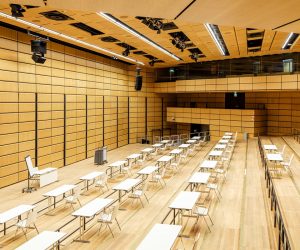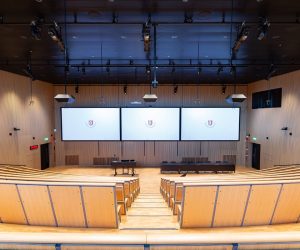
World’s Largest Astronomy Museum
Christie laser projection and content management solutions deliver awe and wonder at Shanghai Astronomy Museum
Christie announces that its state-of-the-art laser projection and content management solutions are delivering awe-inspiring visuals that transport visitors across time and space in the new Shanghai Astronomy Museum.
Located in the Lingang area of Shanghai, the 38,000-square-metre structure is currently the world’s largest museum solely dedicated to the study of astronomy. It is designed by US-based design firm Ennead Architects and features an exterior design without the use of straight lines or right angles, a concept inspired by the orbits of celestial bodies and the geometry of the cosmos. Instead, the building’s three main architectural components – the Oculus, Inverted Dome and Sphere – function as astronomical instruments that track the sun, moon and stars.
The impressive layout extends to the museum’s interiors, where numerous exciting exhibits are powered by advanced audiovisual technologies to provide a highly engaging and immersive experience to visitors. These include projections accomplished by more than 40 Christie HS Series and GS Series 1DLP laser projectors of varying brightness (from 6,350 to 20,600 lumens) and image resolutions, along with real-time video playback and processing achieved by the powerful Christie Pandoras Box V8 and Christie Widget Designer.
Christie’s trusted partners Wincomn Technology and Zhongqing Yingye Group were responsible for the installation and commissioning of all projection solutions across the museum. The suite of Christie Pandoras Box products were installed by Marvel Vision, one of Christie’s distributors for content management and image processing solutions in China.
The HS and GS Series laser projectors are deployed across 12 galleries in the three main exhibition zones titled “Home”, “Cosmos” and “Odyssey”, which lead visitors on a tour around the solar system, faraway galaxies and even black holes. The exhibits are also designed for a greater understanding of the history of astronomy and inspire visitors to think about its future.
 Among the highlights are projections on a huge rotating globe measuring 20 meters in diameter using seven Christie D20WU-HS laser projectors, and interactive projections on a large wall measuring 60 meters in length using 10 Christie DWU1075-GS laser projectors. The D20WU-HS and DWU1075-GS have a brightness of 20,600 and 10,875 lumens respectively. Both models are also equipped with Christie BoldColor Technology that creates the colour balance needed to accurately reproduce colourful images, without sacrificing brightness. In another gallery, highly detailed images of celestial bodies are made possible by three Christie 4K7-HS laser projectors boasting 4K UHD resolution and built-in Christie Twist for multi-projector setups.
Among the highlights are projections on a huge rotating globe measuring 20 meters in diameter using seven Christie D20WU-HS laser projectors, and interactive projections on a large wall measuring 60 meters in length using 10 Christie DWU1075-GS laser projectors. The D20WU-HS and DWU1075-GS have a brightness of 20,600 and 10,875 lumens respectively. Both models are also equipped with Christie BoldColor Technology that creates the colour balance needed to accurately reproduce colourful images, without sacrificing brightness. In another gallery, highly detailed images of celestial bodies are made possible by three Christie 4K7-HS laser projectors boasting 4K UHD resolution and built-in Christie Twist for multi-projector setups.
In the “Odyssey” exhibition zone, visuals displayed on a 50-meter-long ribbon-like “cosmic thread” are achieved using 10 Christie DWU630-GS laser projectors and Christie Pandoras Box V8 Software License, which comes with a host of professional new features, a simplified workflow and streamlined licensing. This single license contains the full suite of Pandoras Box software to deliver the high-level media processing performance required for various applications, including fixed installations, live events, theatres and other entertainment environments.
 “Pandoras Box Version 8 is the ideal software solution for various applications such as the elaborate multimedia exhibits in Shanghai Astronomy Museum,” said Gary Wang, sales representative for China, Enterprise, Christie. “With Version 8, a myriad of images can be perfectly displayed on various surfaces, allowing content designers and developers to express their creativity and bring their visions to reality any time, with any hardware.”
“Pandoras Box Version 8 is the ideal software solution for various applications such as the elaborate multimedia exhibits in Shanghai Astronomy Museum,” said Gary Wang, sales representative for China, Enterprise, Christie. “With Version 8, a myriad of images can be perfectly displayed on various surfaces, allowing content designers and developers to express their creativity and bring their visions to reality any time, with any hardware.”
Featuring laser illumination, the Christie HS and GS Series eliminate the need for lamp and filter replacements, providing 20,000 hours of low-cost operation. Wireless connectivity, a small footprint, low-weight, quiet operation and a full range of lenses make them ideal for demanding, high-use applications.
Christie: christiedigital.com














RESPONSES